Computer Security: Elements, Issues, and Frameworks
VerifiedAdded on 2023/01/18
|15
|5037
|1
AI Summary
This document provides an overview of computer security, including the elements of computer security, key issues, and evaluation of cyber security frameworks. It discusses countermeasures and preventative measures for computer security, with a focus on protecting computers from threats. The document also includes a case study on a utility company's website attacked by a botnet and provides insights into the code of conduct needed for IT professionals.
Contribute Materials
Your contribution can guide someone’s learning journey. Share your
documents today.
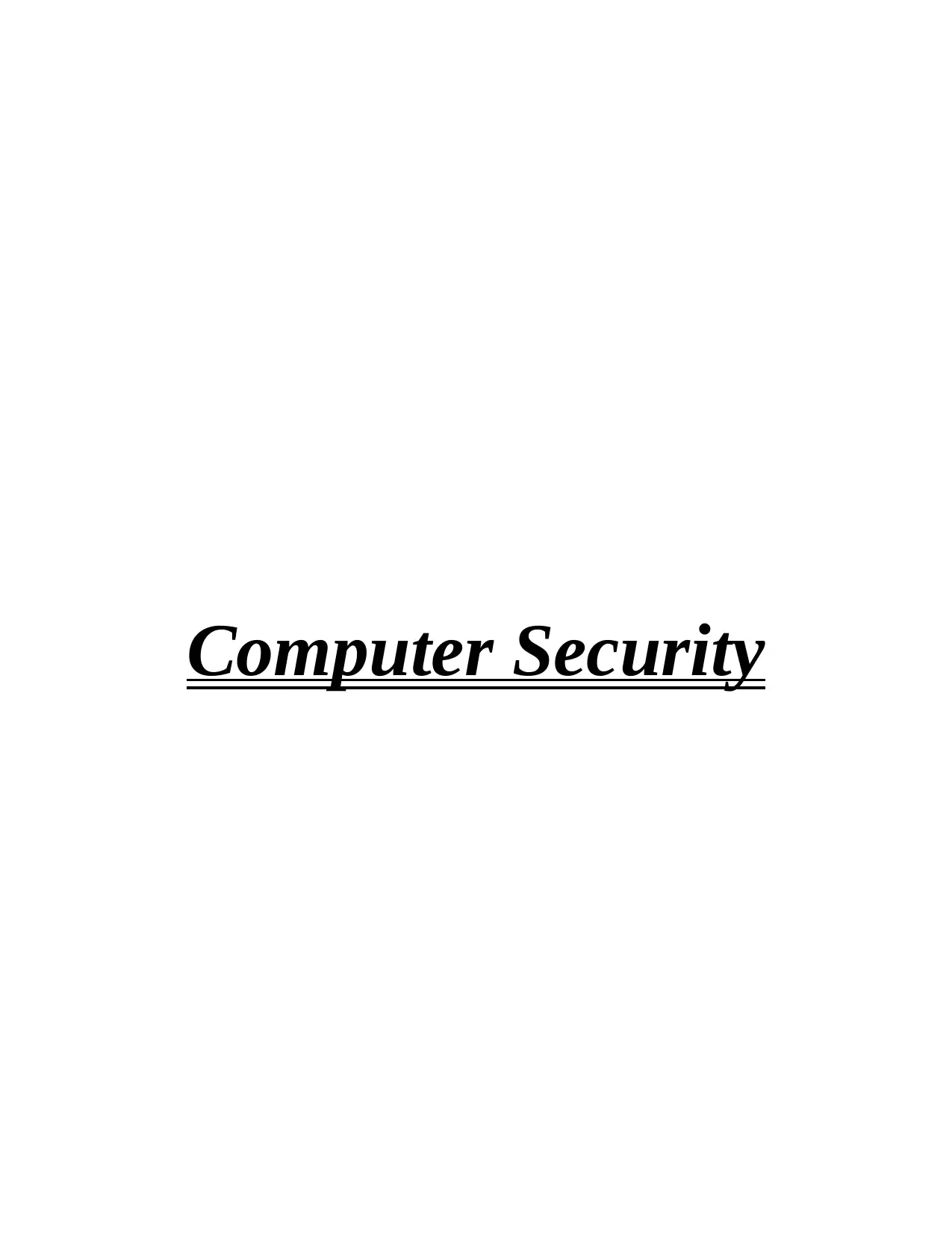
Computer Security
Secure Best Marks with AI Grader
Need help grading? Try our AI Grader for instant feedback on your assignments.
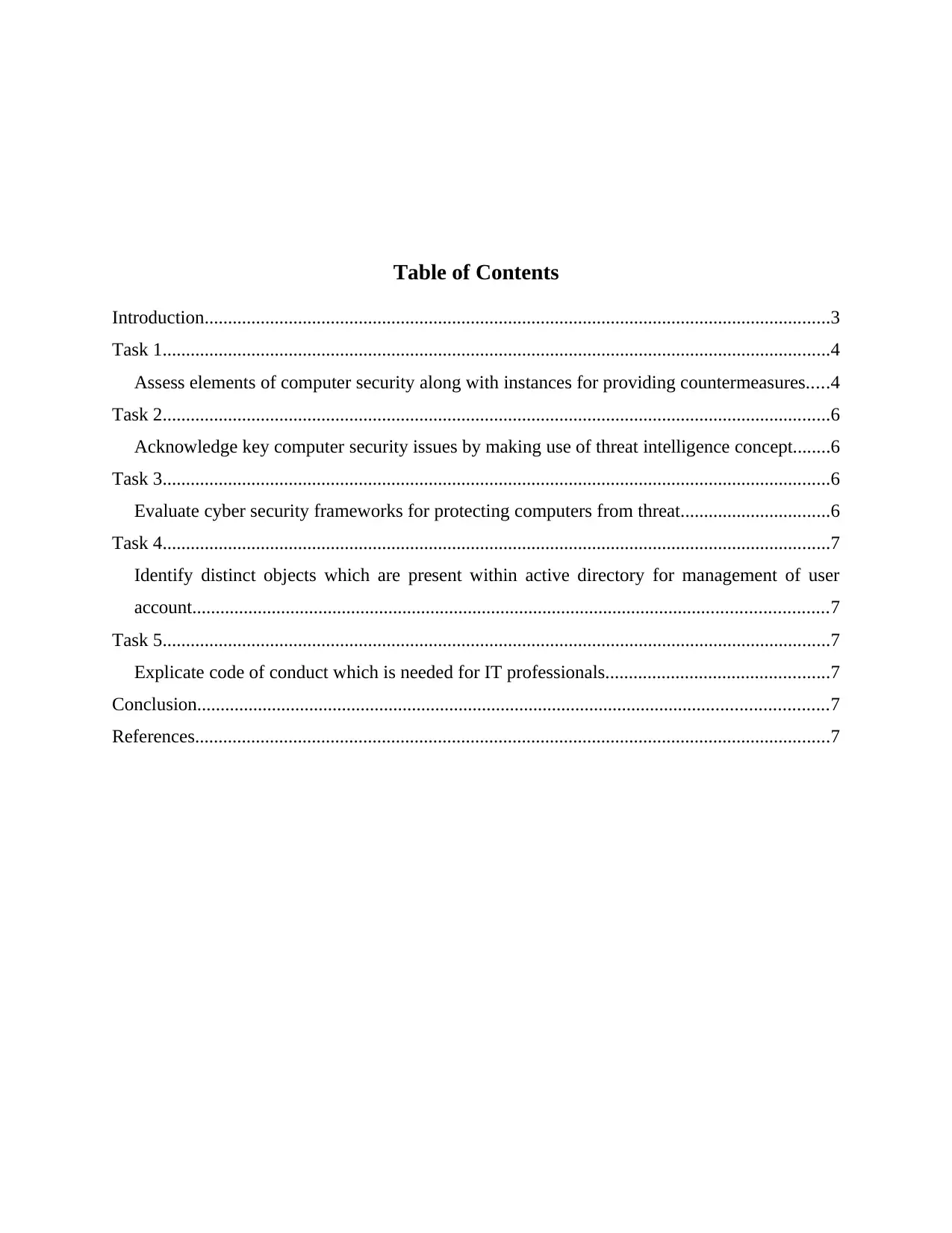
Table of Contents
Introduction......................................................................................................................................3
Task 1...............................................................................................................................................4
Assess elements of computer security along with instances for providing countermeasures.....4
Task 2...............................................................................................................................................6
Acknowledge key computer security issues by making use of threat intelligence concept........6
Task 3...............................................................................................................................................6
Evaluate cyber security frameworks for protecting computers from threat................................6
Task 4...............................................................................................................................................7
Identify distinct objects which are present within active directory for management of user
account........................................................................................................................................7
Task 5...............................................................................................................................................7
Explicate code of conduct which is needed for IT professionals................................................7
Conclusion.......................................................................................................................................7
References........................................................................................................................................7
Introduction......................................................................................................................................3
Task 1...............................................................................................................................................4
Assess elements of computer security along with instances for providing countermeasures.....4
Task 2...............................................................................................................................................6
Acknowledge key computer security issues by making use of threat intelligence concept........6
Task 3...............................................................................................................................................6
Evaluate cyber security frameworks for protecting computers from threat................................6
Task 4...............................................................................................................................................7
Identify distinct objects which are present within active directory for management of user
account........................................................................................................................................7
Task 5...............................................................................................................................................7
Explicate code of conduct which is needed for IT professionals................................................7
Conclusion.......................................................................................................................................7
References........................................................................................................................................7
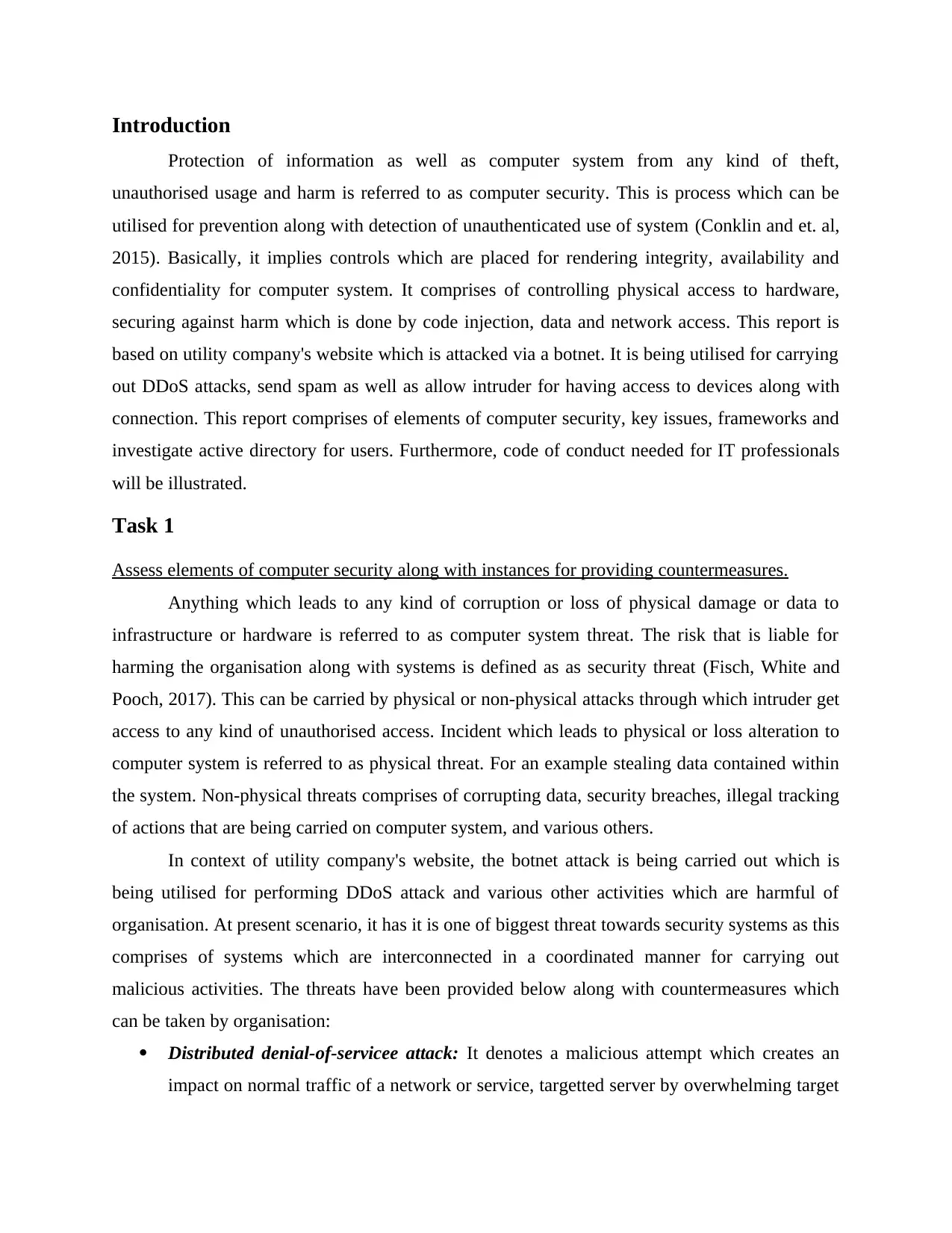
Introduction
Protection of information as well as computer system from any kind of theft,
unauthorised usage and harm is referred to as computer security. This is process which can be
utilised for prevention along with detection of unauthenticated use of system (Conklin and et. al,
2015). Basically, it implies controls which are placed for rendering integrity, availability and
confidentiality for computer system. It comprises of controlling physical access to hardware,
securing against harm which is done by code injection, data and network access. This report is
based on utility company's website which is attacked via a botnet. It is being utilised for carrying
out DDoS attacks, send spam as well as allow intruder for having access to devices along with
connection. This report comprises of elements of computer security, key issues, frameworks and
investigate active directory for users. Furthermore, code of conduct needed for IT professionals
will be illustrated.
Task 1
Assess elements of computer security along with instances for providing countermeasures.
Anything which leads to any kind of corruption or loss of physical damage or data to
infrastructure or hardware is referred to as computer system threat. The risk that is liable for
harming the organisation along with systems is defined as as security threat (Fisch, White and
Pooch, 2017). This can be carried by physical or non-physical attacks through which intruder get
access to any kind of unauthorised access. Incident which leads to physical or loss alteration to
computer system is referred to as physical threat. For an example stealing data contained within
the system. Non-physical threats comprises of corrupting data, security breaches, illegal tracking
of actions that are being carried on computer system, and various others.
In context of utility company's website, the botnet attack is being carried out which is
being utilised for performing DDoS attack and various other activities which are harmful of
organisation. At present scenario, it has it is one of biggest threat towards security systems as this
comprises of systems which are interconnected in a coordinated manner for carrying out
malicious activities. The threats have been provided below along with countermeasures which
can be taken by organisation:
Distributed denial-of-servicee attack: It denotes a malicious attempt which creates an
impact on normal traffic of a network or service, targetted server by overwhelming target
Protection of information as well as computer system from any kind of theft,
unauthorised usage and harm is referred to as computer security. This is process which can be
utilised for prevention along with detection of unauthenticated use of system (Conklin and et. al,
2015). Basically, it implies controls which are placed for rendering integrity, availability and
confidentiality for computer system. It comprises of controlling physical access to hardware,
securing against harm which is done by code injection, data and network access. This report is
based on utility company's website which is attacked via a botnet. It is being utilised for carrying
out DDoS attacks, send spam as well as allow intruder for having access to devices along with
connection. This report comprises of elements of computer security, key issues, frameworks and
investigate active directory for users. Furthermore, code of conduct needed for IT professionals
will be illustrated.
Task 1
Assess elements of computer security along with instances for providing countermeasures.
Anything which leads to any kind of corruption or loss of physical damage or data to
infrastructure or hardware is referred to as computer system threat. The risk that is liable for
harming the organisation along with systems is defined as as security threat (Fisch, White and
Pooch, 2017). This can be carried by physical or non-physical attacks through which intruder get
access to any kind of unauthorised access. Incident which leads to physical or loss alteration to
computer system is referred to as physical threat. For an example stealing data contained within
the system. Non-physical threats comprises of corrupting data, security breaches, illegal tracking
of actions that are being carried on computer system, and various others.
In context of utility company's website, the botnet attack is being carried out which is
being utilised for performing DDoS attack and various other activities which are harmful of
organisation. At present scenario, it has it is one of biggest threat towards security systems as this
comprises of systems which are interconnected in a coordinated manner for carrying out
malicious activities. The threats have been provided below along with countermeasures which
can be taken by organisation:
Distributed denial-of-servicee attack: It denotes a malicious attempt which creates an
impact on normal traffic of a network or service, targetted server by overwhelming target
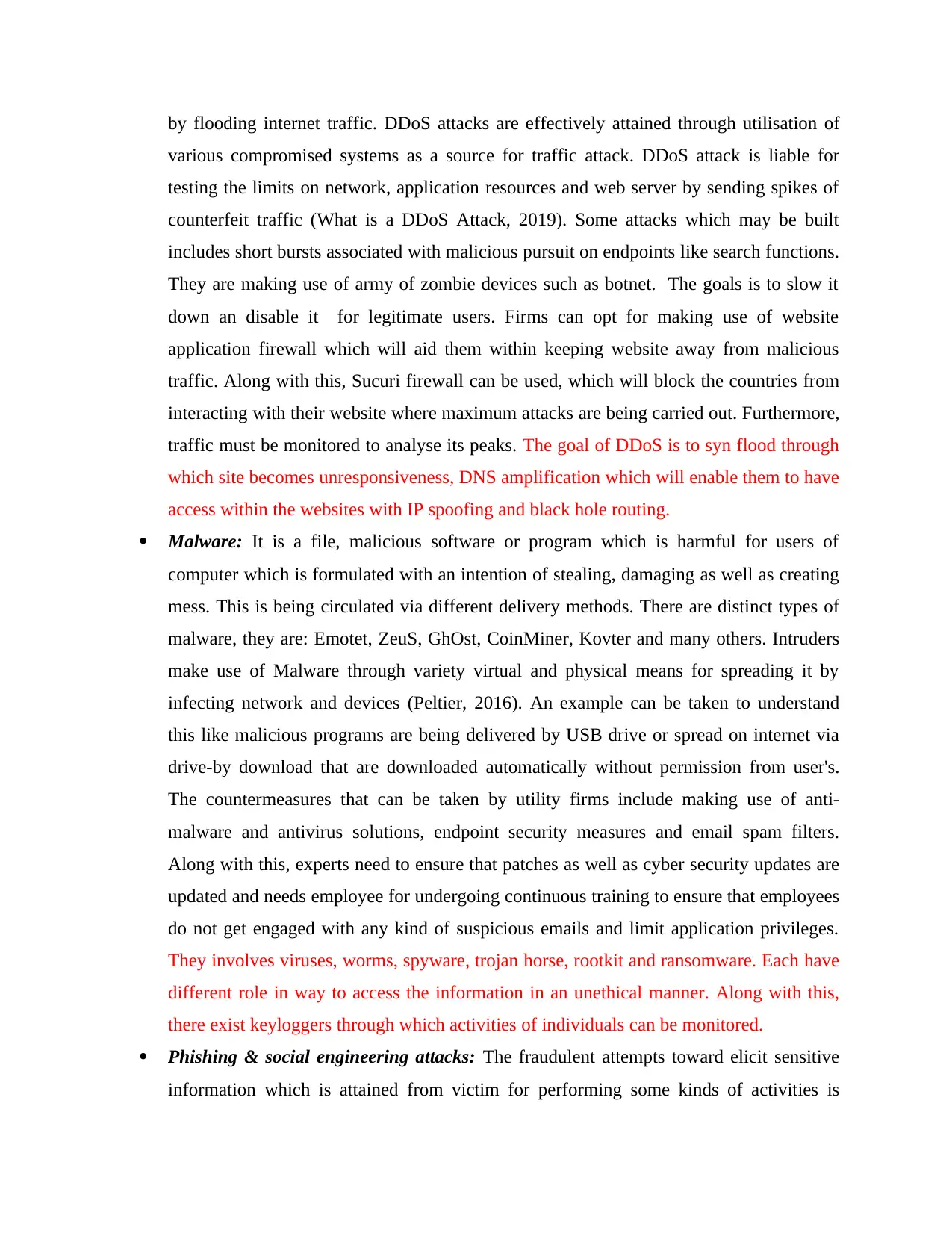
by flooding internet traffic. DDoS attacks are effectively attained through utilisation of
various compromised systems as a source for traffic attack. DDoS attack is liable for
testing the limits on network, application resources and web server by sending spikes of
counterfeit traffic (What is a DDoS Attack, 2019). Some attacks which may be built
includes short bursts associated with malicious pursuit on endpoints like search functions.
They are making use of army of zombie devices such as botnet. The goals is to slow it
down an disable it for legitimate users. Firms can opt for making use of website
application firewall which will aid them within keeping website away from malicious
traffic. Along with this, Sucuri firewall can be used, which will block the countries from
interacting with their website where maximum attacks are being carried out. Furthermore,
traffic must be monitored to analyse its peaks. The goal of DDoS is to syn flood through
which site becomes unresponsiveness, DNS amplification which will enable them to have
access within the websites with IP spoofing and black hole routing.
Malware: It is a file, malicious software or program which is harmful for users of
computer which is formulated with an intention of stealing, damaging as well as creating
mess. This is being circulated via different delivery methods. There are distinct types of
malware, they are: Emotet, ZeuS, GhOst, CoinMiner, Kovter and many others. Intruders
make use of Malware through variety virtual and physical means for spreading it by
infecting network and devices (Peltier, 2016). An example can be taken to understand
this like malicious programs are being delivered by USB drive or spread on internet via
drive-by download that are downloaded automatically without permission from user's.
The countermeasures that can be taken by utility firms include making use of anti-
malware and antivirus solutions, endpoint security measures and email spam filters.
Along with this, experts need to ensure that patches as well as cyber security updates are
updated and needs employee for undergoing continuous training to ensure that employees
do not get engaged with any kind of suspicious emails and limit application privileges.
They involves viruses, worms, spyware, trojan horse, rootkit and ransomware. Each have
different role in way to access the information in an unethical manner. Along with this,
there exist keyloggers through which activities of individuals can be monitored.
Phishing & social engineering attacks: The fraudulent attempts toward elicit sensitive
information which is attained from victim for performing some kinds of activities is
various compromised systems as a source for traffic attack. DDoS attack is liable for
testing the limits on network, application resources and web server by sending spikes of
counterfeit traffic (What is a DDoS Attack, 2019). Some attacks which may be built
includes short bursts associated with malicious pursuit on endpoints like search functions.
They are making use of army of zombie devices such as botnet. The goals is to slow it
down an disable it for legitimate users. Firms can opt for making use of website
application firewall which will aid them within keeping website away from malicious
traffic. Along with this, Sucuri firewall can be used, which will block the countries from
interacting with their website where maximum attacks are being carried out. Furthermore,
traffic must be monitored to analyse its peaks. The goal of DDoS is to syn flood through
which site becomes unresponsiveness, DNS amplification which will enable them to have
access within the websites with IP spoofing and black hole routing.
Malware: It is a file, malicious software or program which is harmful for users of
computer which is formulated with an intention of stealing, damaging as well as creating
mess. This is being circulated via different delivery methods. There are distinct types of
malware, they are: Emotet, ZeuS, GhOst, CoinMiner, Kovter and many others. Intruders
make use of Malware through variety virtual and physical means for spreading it by
infecting network and devices (Peltier, 2016). An example can be taken to understand
this like malicious programs are being delivered by USB drive or spread on internet via
drive-by download that are downloaded automatically without permission from user's.
The countermeasures that can be taken by utility firms include making use of anti-
malware and antivirus solutions, endpoint security measures and email spam filters.
Along with this, experts need to ensure that patches as well as cyber security updates are
updated and needs employee for undergoing continuous training to ensure that employees
do not get engaged with any kind of suspicious emails and limit application privileges.
They involves viruses, worms, spyware, trojan horse, rootkit and ransomware. Each have
different role in way to access the information in an unethical manner. Along with this,
there exist keyloggers through which activities of individuals can be monitored.
Phishing & social engineering attacks: The fraudulent attempts toward elicit sensitive
information which is attained from victim for performing some kinds of activities is
Secure Best Marks with AI Grader
Need help grading? Try our AI Grader for instant feedback on your assignments.
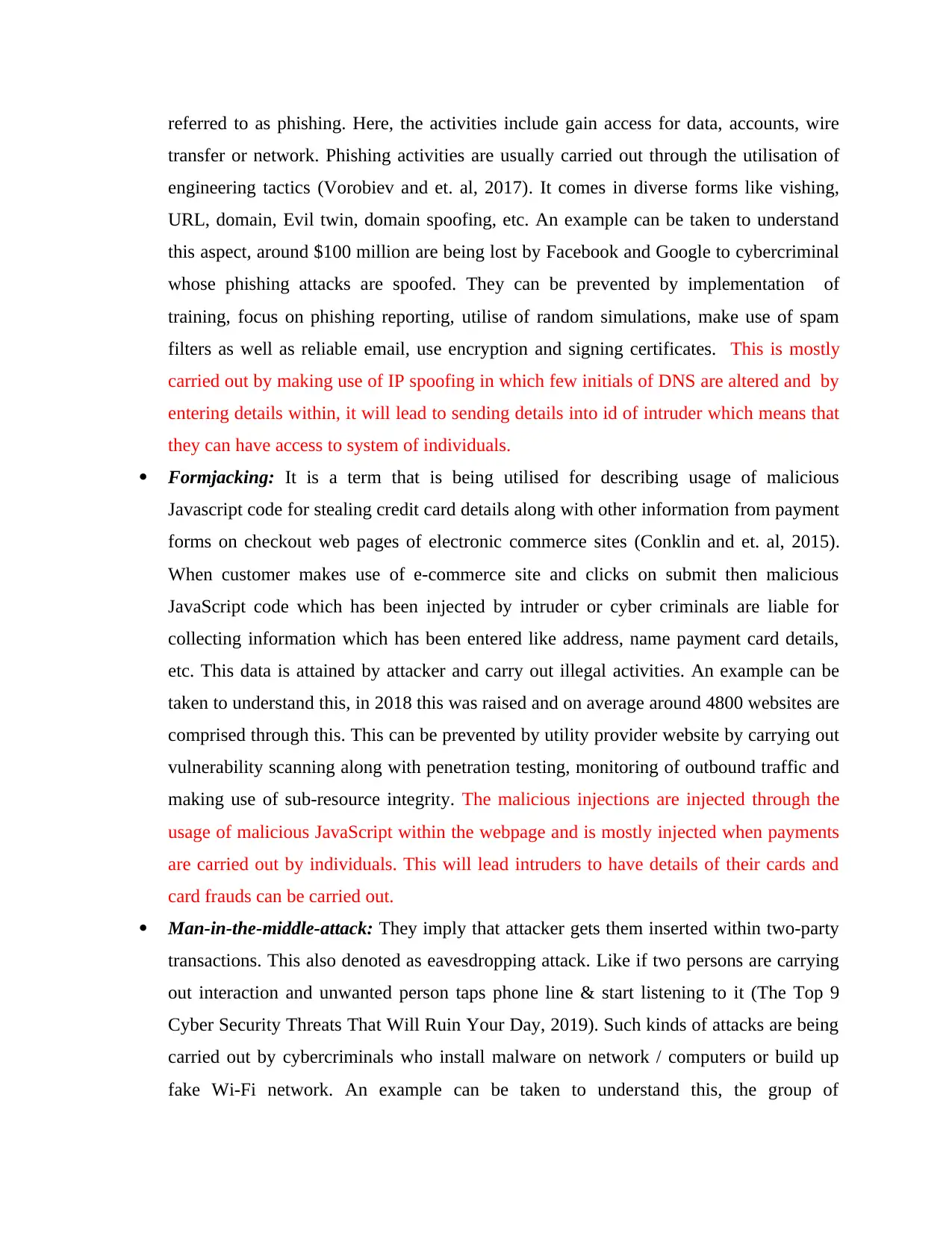
referred to as phishing. Here, the activities include gain access for data, accounts, wire
transfer or network. Phishing activities are usually carried out through the utilisation of
engineering tactics (Vorobiev and et. al, 2017). It comes in diverse forms like vishing,
URL, domain, Evil twin, domain spoofing, etc. An example can be taken to understand
this aspect, around $100 million are being lost by Facebook and Google to cybercriminal
whose phishing attacks are spoofed. They can be prevented by implementation of
training, focus on phishing reporting, utilise of random simulations, make use of spam
filters as well as reliable email, use encryption and signing certificates. This is mostly
carried out by making use of IP spoofing in which few initials of DNS are altered and by
entering details within, it will lead to sending details into id of intruder which means that
they can have access to system of individuals.
Formjacking: It is a term that is being utilised for describing usage of malicious
Javascript code for stealing credit card details along with other information from payment
forms on checkout web pages of electronic commerce sites (Conklin and et. al, 2015).
When customer makes use of e-commerce site and clicks on submit then malicious
JavaScript code which has been injected by intruder or cyber criminals are liable for
collecting information which has been entered like address, name payment card details,
etc. This data is attained by attacker and carry out illegal activities. An example can be
taken to understand this, in 2018 this was raised and on average around 4800 websites are
comprised through this. This can be prevented by utility provider website by carrying out
vulnerability scanning along with penetration testing, monitoring of outbound traffic and
making use of sub-resource integrity. The malicious injections are injected through the
usage of malicious JavaScript within the webpage and is mostly injected when payments
are carried out by individuals. This will lead intruders to have details of their cards and
card frauds can be carried out.
Man-in-the-middle-attack: They imply that attacker gets them inserted within two-party
transactions. This also denoted as eavesdropping attack. Like if two persons are carrying
out interaction and unwanted person taps phone line & start listening to it (The Top 9
Cyber Security Threats That Will Ruin Your Day, 2019). Such kinds of attacks are being
carried out by cybercriminals who install malware on network / computers or build up
fake Wi-Fi network. An example can be taken to understand this, the group of
transfer or network. Phishing activities are usually carried out through the utilisation of
engineering tactics (Vorobiev and et. al, 2017). It comes in diverse forms like vishing,
URL, domain, Evil twin, domain spoofing, etc. An example can be taken to understand
this aspect, around $100 million are being lost by Facebook and Google to cybercriminal
whose phishing attacks are spoofed. They can be prevented by implementation of
training, focus on phishing reporting, utilise of random simulations, make use of spam
filters as well as reliable email, use encryption and signing certificates. This is mostly
carried out by making use of IP spoofing in which few initials of DNS are altered and by
entering details within, it will lead to sending details into id of intruder which means that
they can have access to system of individuals.
Formjacking: It is a term that is being utilised for describing usage of malicious
Javascript code for stealing credit card details along with other information from payment
forms on checkout web pages of electronic commerce sites (Conklin and et. al, 2015).
When customer makes use of e-commerce site and clicks on submit then malicious
JavaScript code which has been injected by intruder or cyber criminals are liable for
collecting information which has been entered like address, name payment card details,
etc. This data is attained by attacker and carry out illegal activities. An example can be
taken to understand this, in 2018 this was raised and on average around 4800 websites are
comprised through this. This can be prevented by utility provider website by carrying out
vulnerability scanning along with penetration testing, monitoring of outbound traffic and
making use of sub-resource integrity. The malicious injections are injected through the
usage of malicious JavaScript within the webpage and is mostly injected when payments
are carried out by individuals. This will lead intruders to have details of their cards and
card frauds can be carried out.
Man-in-the-middle-attack: They imply that attacker gets them inserted within two-party
transactions. This also denoted as eavesdropping attack. Like if two persons are carrying
out interaction and unwanted person taps phone line & start listening to it (The Top 9
Cyber Security Threats That Will Ruin Your Day, 2019). Such kinds of attacks are being
carried out by cybercriminals who install malware on network / computers or build up
fake Wi-Fi network. An example can be taken to understand this, the group of
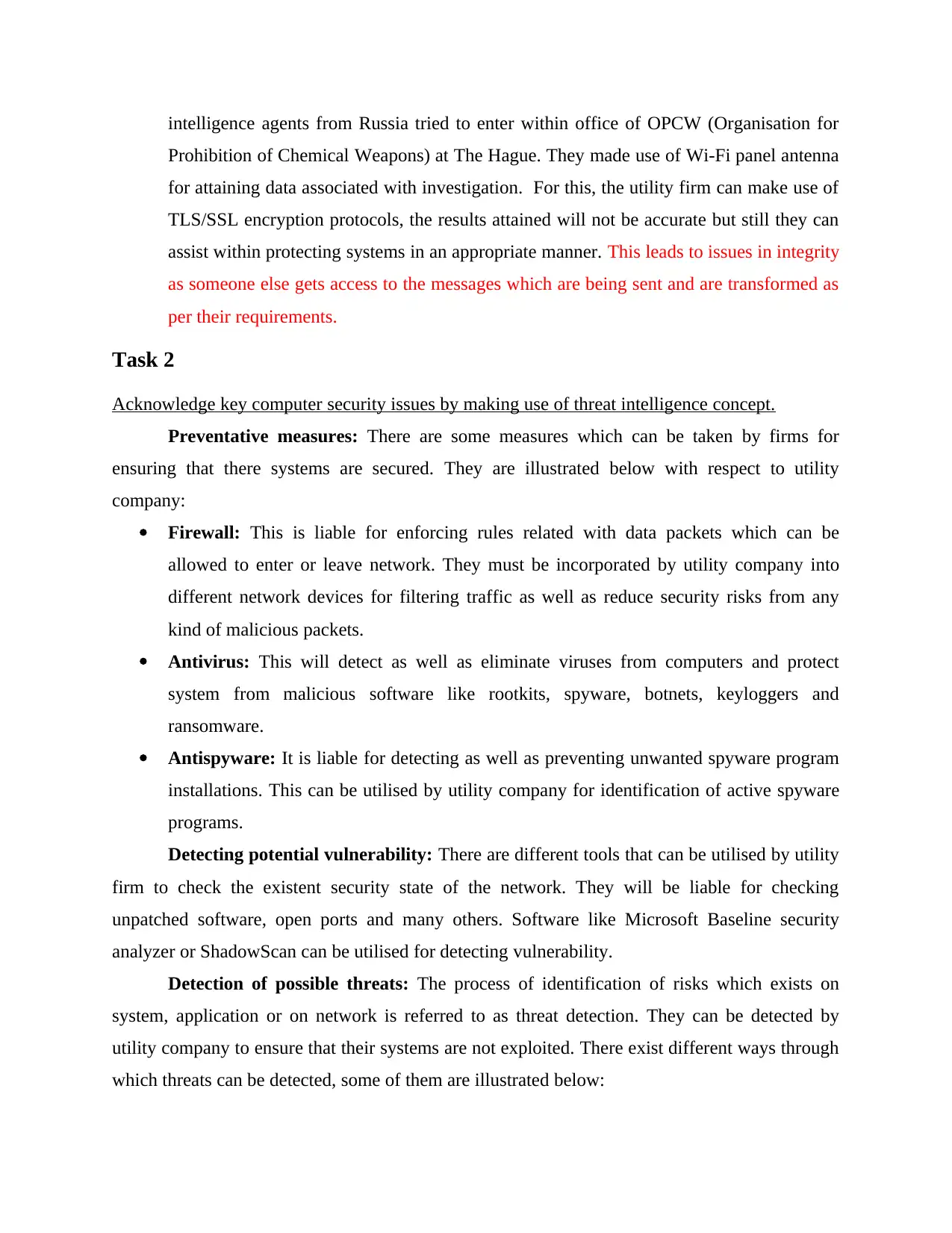
intelligence agents from Russia tried to enter within office of OPCW (Organisation for
Prohibition of Chemical Weapons) at The Hague. They made use of Wi-Fi panel antenna
for attaining data associated with investigation. For this, the utility firm can make use of
TLS/SSL encryption protocols, the results attained will not be accurate but still they can
assist within protecting systems in an appropriate manner. This leads to issues in integrity
as someone else gets access to the messages which are being sent and are transformed as
per their requirements.
Task 2
Acknowledge key computer security issues by making use of threat intelligence concept.
Preventative measures: There are some measures which can be taken by firms for
ensuring that there systems are secured. They are illustrated below with respect to utility
company:
Firewall: This is liable for enforcing rules related with data packets which can be
allowed to enter or leave network. They must be incorporated by utility company into
different network devices for filtering traffic as well as reduce security risks from any
kind of malicious packets.
Antivirus: This will detect as well as eliminate viruses from computers and protect
system from malicious software like rootkits, spyware, botnets, keyloggers and
ransomware.
Antispyware: It is liable for detecting as well as preventing unwanted spyware program
installations. This can be utilised by utility company for identification of active spyware
programs.
Detecting potential vulnerability: There are different tools that can be utilised by utility
firm to check the existent security state of the network. They will be liable for checking
unpatched software, open ports and many others. Software like Microsoft Baseline security
analyzer or ShadowScan can be utilised for detecting vulnerability.
Detection of possible threats: The process of identification of risks which exists on
system, application or on network is referred to as threat detection. They can be detected by
utility company to ensure that their systems are not exploited. There exist different ways through
which threats can be detected, some of them are illustrated below:
Prohibition of Chemical Weapons) at The Hague. They made use of Wi-Fi panel antenna
for attaining data associated with investigation. For this, the utility firm can make use of
TLS/SSL encryption protocols, the results attained will not be accurate but still they can
assist within protecting systems in an appropriate manner. This leads to issues in integrity
as someone else gets access to the messages which are being sent and are transformed as
per their requirements.
Task 2
Acknowledge key computer security issues by making use of threat intelligence concept.
Preventative measures: There are some measures which can be taken by firms for
ensuring that there systems are secured. They are illustrated below with respect to utility
company:
Firewall: This is liable for enforcing rules related with data packets which can be
allowed to enter or leave network. They must be incorporated by utility company into
different network devices for filtering traffic as well as reduce security risks from any
kind of malicious packets.
Antivirus: This will detect as well as eliminate viruses from computers and protect
system from malicious software like rootkits, spyware, botnets, keyloggers and
ransomware.
Antispyware: It is liable for detecting as well as preventing unwanted spyware program
installations. This can be utilised by utility company for identification of active spyware
programs.
Detecting potential vulnerability: There are different tools that can be utilised by utility
firm to check the existent security state of the network. They will be liable for checking
unpatched software, open ports and many others. Software like Microsoft Baseline security
analyzer or ShadowScan can be utilised for detecting vulnerability.
Detection of possible threats: The process of identification of risks which exists on
system, application or on network is referred to as threat detection. They can be detected by
utility company to ensure that their systems are not exploited. There exist different ways through
which threats can be detected, some of them are illustrated below:
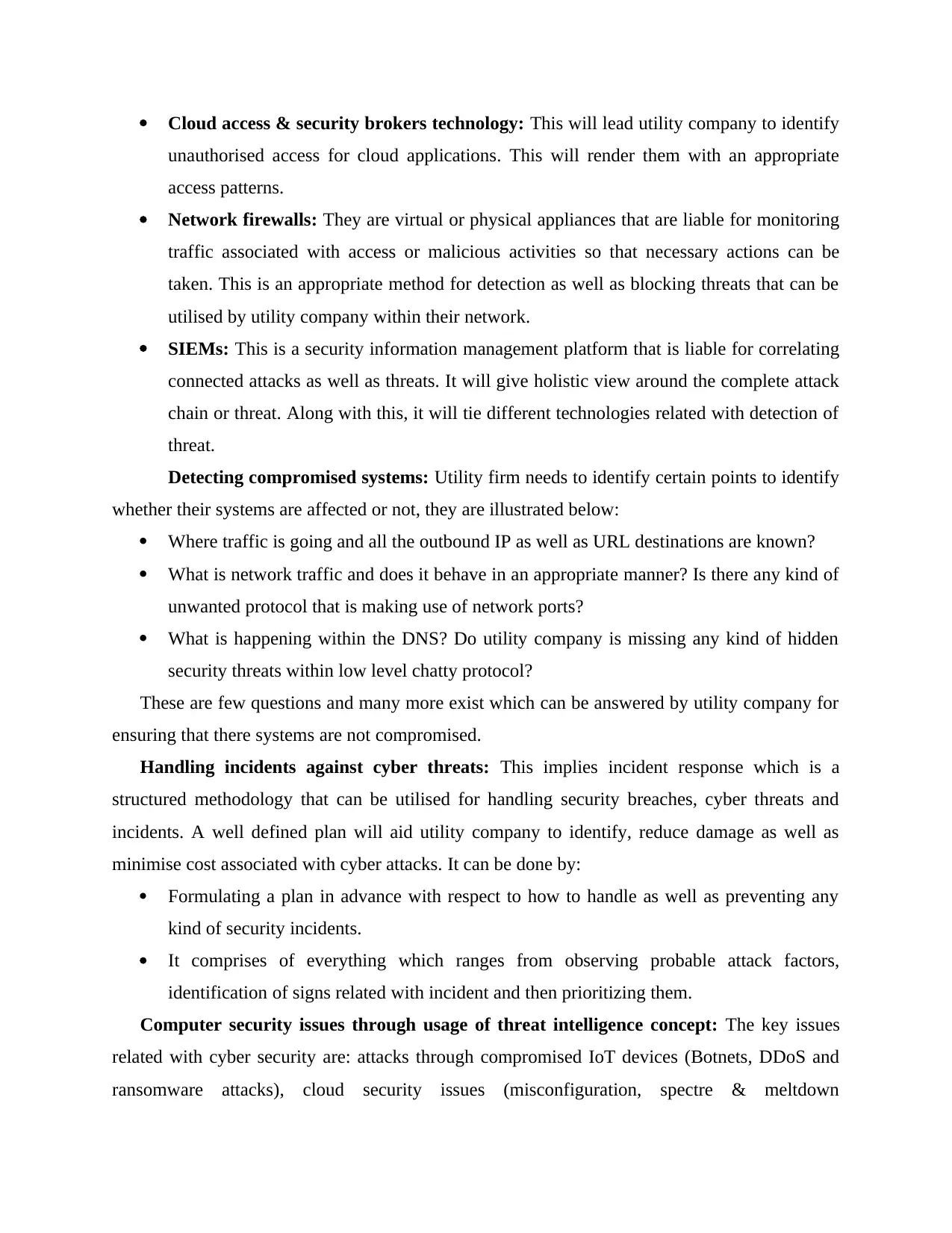
Cloud access & security brokers technology: This will lead utility company to identify
unauthorised access for cloud applications. This will render them with an appropriate
access patterns.
Network firewalls: They are virtual or physical appliances that are liable for monitoring
traffic associated with access or malicious activities so that necessary actions can be
taken. This is an appropriate method for detection as well as blocking threats that can be
utilised by utility company within their network.
SIEMs: This is a security information management platform that is liable for correlating
connected attacks as well as threats. It will give holistic view around the complete attack
chain or threat. Along with this, it will tie different technologies related with detection of
threat.
Detecting compromised systems: Utility firm needs to identify certain points to identify
whether their systems are affected or not, they are illustrated below:
Where traffic is going and all the outbound IP as well as URL destinations are known?
What is network traffic and does it behave in an appropriate manner? Is there any kind of
unwanted protocol that is making use of network ports?
What is happening within the DNS? Do utility company is missing any kind of hidden
security threats within low level chatty protocol?
These are few questions and many more exist which can be answered by utility company for
ensuring that there systems are not compromised.
Handling incidents against cyber threats: This implies incident response which is a
structured methodology that can be utilised for handling security breaches, cyber threats and
incidents. A well defined plan will aid utility company to identify, reduce damage as well as
minimise cost associated with cyber attacks. It can be done by:
Formulating a plan in advance with respect to how to handle as well as preventing any
kind of security incidents.
It comprises of everything which ranges from observing probable attack factors,
identification of signs related with incident and then prioritizing them.
Computer security issues through usage of threat intelligence concept: The key issues
related with cyber security are: attacks through compromised IoT devices (Botnets, DDoS and
ransomware attacks), cloud security issues (misconfiguration, spectre & meltdown
unauthorised access for cloud applications. This will render them with an appropriate
access patterns.
Network firewalls: They are virtual or physical appliances that are liable for monitoring
traffic associated with access or malicious activities so that necessary actions can be
taken. This is an appropriate method for detection as well as blocking threats that can be
utilised by utility company within their network.
SIEMs: This is a security information management platform that is liable for correlating
connected attacks as well as threats. It will give holistic view around the complete attack
chain or threat. Along with this, it will tie different technologies related with detection of
threat.
Detecting compromised systems: Utility firm needs to identify certain points to identify
whether their systems are affected or not, they are illustrated below:
Where traffic is going and all the outbound IP as well as URL destinations are known?
What is network traffic and does it behave in an appropriate manner? Is there any kind of
unwanted protocol that is making use of network ports?
What is happening within the DNS? Do utility company is missing any kind of hidden
security threats within low level chatty protocol?
These are few questions and many more exist which can be answered by utility company for
ensuring that there systems are not compromised.
Handling incidents against cyber threats: This implies incident response which is a
structured methodology that can be utilised for handling security breaches, cyber threats and
incidents. A well defined plan will aid utility company to identify, reduce damage as well as
minimise cost associated with cyber attacks. It can be done by:
Formulating a plan in advance with respect to how to handle as well as preventing any
kind of security incidents.
It comprises of everything which ranges from observing probable attack factors,
identification of signs related with incident and then prioritizing them.
Computer security issues through usage of threat intelligence concept: The key issues
related with cyber security are: attacks through compromised IoT devices (Botnets, DDoS and
ransomware attacks), cloud security issues (misconfiguration, spectre & meltdown
Paraphrase This Document
Need a fresh take? Get an instant paraphrase of this document with our AI Paraphraser
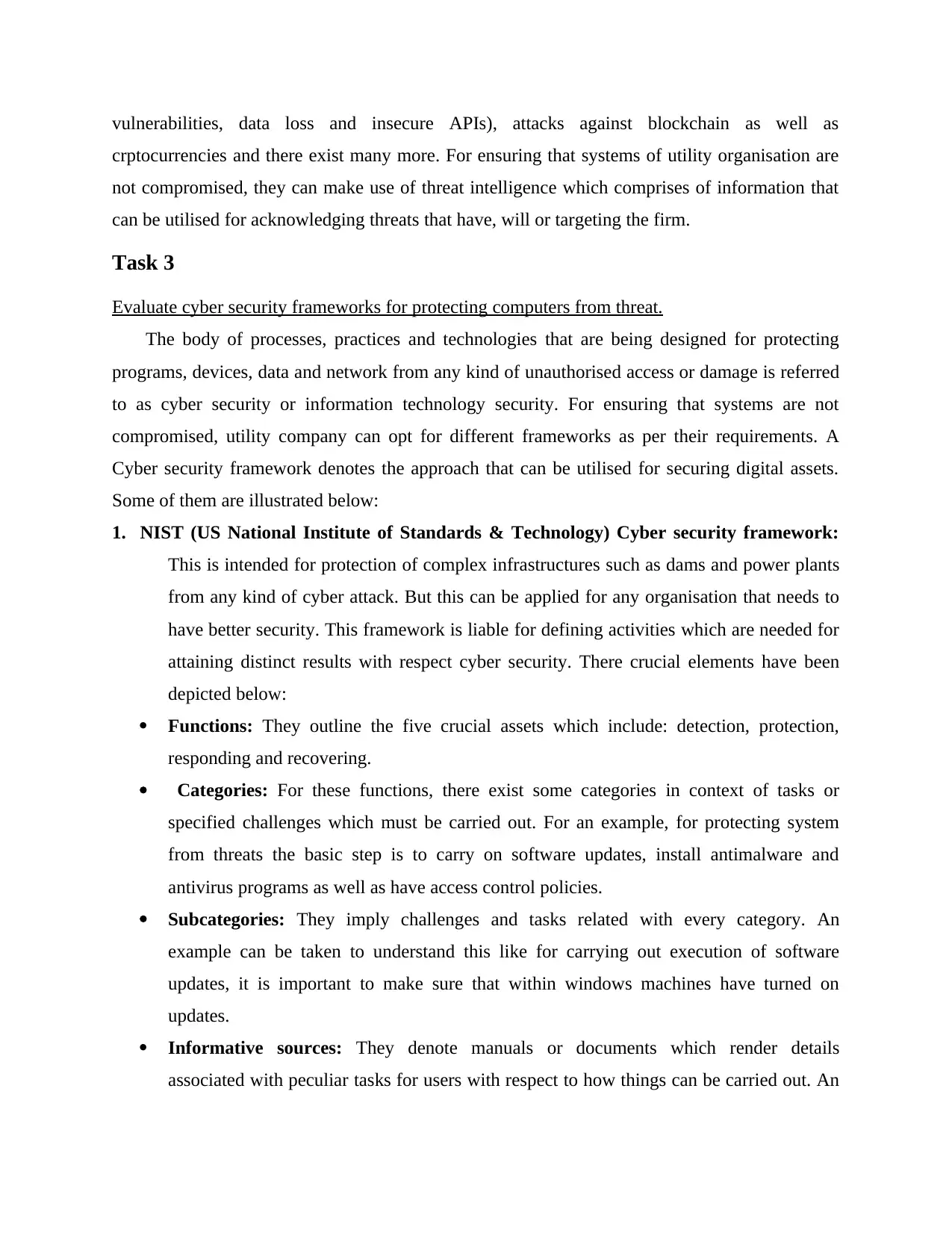
vulnerabilities, data loss and insecure APIs), attacks against blockchain as well as
crptocurrencies and there exist many more. For ensuring that systems of utility organisation are
not compromised, they can make use of threat intelligence which comprises of information that
can be utilised for acknowledging threats that have, will or targeting the firm.
Task 3
Evaluate cyber security frameworks for protecting computers from threat.
The body of processes, practices and technologies that are being designed for protecting
programs, devices, data and network from any kind of unauthorised access or damage is referred
to as cyber security or information technology security. For ensuring that systems are not
compromised, utility company can opt for different frameworks as per their requirements. A
Cyber security framework denotes the approach that can be utilised for securing digital assets.
Some of them are illustrated below:
1. NIST (US National Institute of Standards & Technology) Cyber security framework:
This is intended for protection of complex infrastructures such as dams and power plants
from any kind of cyber attack. But this can be applied for any organisation that needs to
have better security. This framework is liable for defining activities which are needed for
attaining distinct results with respect cyber security. There crucial elements have been
depicted below:
Functions: They outline the five crucial assets which include: detection, protection,
responding and recovering.
Categories: For these functions, there exist some categories in context of tasks or
specified challenges which must be carried out. For an example, for protecting system
from threats the basic step is to carry on software updates, install antimalware and
antivirus programs as well as have access control policies.
Subcategories: They imply challenges and tasks related with every category. An
example can be taken to understand this like for carrying out execution of software
updates, it is important to make sure that within windows machines have turned on
updates.
Informative sources: They denote manuals or documents which render details
associated with peculiar tasks for users with respect to how things can be carried out. An
crptocurrencies and there exist many more. For ensuring that systems of utility organisation are
not compromised, they can make use of threat intelligence which comprises of information that
can be utilised for acknowledging threats that have, will or targeting the firm.
Task 3
Evaluate cyber security frameworks for protecting computers from threat.
The body of processes, practices and technologies that are being designed for protecting
programs, devices, data and network from any kind of unauthorised access or damage is referred
to as cyber security or information technology security. For ensuring that systems are not
compromised, utility company can opt for different frameworks as per their requirements. A
Cyber security framework denotes the approach that can be utilised for securing digital assets.
Some of them are illustrated below:
1. NIST (US National Institute of Standards & Technology) Cyber security framework:
This is intended for protection of complex infrastructures such as dams and power plants
from any kind of cyber attack. But this can be applied for any organisation that needs to
have better security. This framework is liable for defining activities which are needed for
attaining distinct results with respect cyber security. There crucial elements have been
depicted below:
Functions: They outline the five crucial assets which include: detection, protection,
responding and recovering.
Categories: For these functions, there exist some categories in context of tasks or
specified challenges which must be carried out. For an example, for protecting system
from threats the basic step is to carry on software updates, install antimalware and
antivirus programs as well as have access control policies.
Subcategories: They imply challenges and tasks related with every category. An
example can be taken to understand this like for carrying out execution of software
updates, it is important to make sure that within windows machines have turned on
updates.
Informative sources: They denote manuals or documents which render details
associated with peculiar tasks for users with respect to how things can be carried out. An

instance can be taken like individual needs to have manual which contains detail related
with way in which auto-updates can be carried out.
The framework is liable for for authentication, identity, self-assessing cyber security risks,
managing them with respect to supply chain and disclosure of vulnerability. But its
implementation will not be easy for utility company like how updates can be done along with
this; the answer cannot be attained for how well firm is doing on cyber security.
2. ISO/IEC 27001: This is also referred to ISO 27K which is internationally documented
standard for cyber security. It is based on assumption that firm which is opting for this is
having Information Security Management System (ISMS). This will enable management of
utility company to systematically manage information security risks as well as take into
consideration vulnerabilities and threats related with this. Furthermore, firm is liable for
designing as well as implementing InfoSec (Information Security) controls which are both
comprehensive as well as coherent. The rationale of this is to mitigate the risks taht are
identified. It is a PDCA cycle which has been illustrated below with respect to utility
company:
Plan: This implies establishment of ISMS along with formulation of objectives,
procedures, policies and processes which can be taken for risk management.
Do: It denotes execution of actual working of ISMS which comprises of
implementation of InfoSec procedures, policies and many others.
Check: This involves review as well as monitoring of ISMS for measuring
performance of process with respect to objectives and policies.
Act: It is process associated with updating as well as improvisation of Information
security management system (ISMS). It denotes undertaking of preventive as well as
corrective actions in context of management review and internal audit.
ISO 2007 will render utility firm with benefits to business, understanding, and state of art,
protection of businesses, technical agreements, interoperability, skills enrichment & avoidance of
risk and worldwide technological compatibility along with efficiency and satisfaction of
customers. But apart from this, there exist some drawbacks which must be taken into
consideration by utility company like this needs peculiar IT budget and which can be expensive,
needs specialised expertise, be deficient in of knowledge, time is needed for applying this and it
with way in which auto-updates can be carried out.
The framework is liable for for authentication, identity, self-assessing cyber security risks,
managing them with respect to supply chain and disclosure of vulnerability. But its
implementation will not be easy for utility company like how updates can be done along with
this; the answer cannot be attained for how well firm is doing on cyber security.
2. ISO/IEC 27001: This is also referred to ISO 27K which is internationally documented
standard for cyber security. It is based on assumption that firm which is opting for this is
having Information Security Management System (ISMS). This will enable management of
utility company to systematically manage information security risks as well as take into
consideration vulnerabilities and threats related with this. Furthermore, firm is liable for
designing as well as implementing InfoSec (Information Security) controls which are both
comprehensive as well as coherent. The rationale of this is to mitigate the risks taht are
identified. It is a PDCA cycle which has been illustrated below with respect to utility
company:
Plan: This implies establishment of ISMS along with formulation of objectives,
procedures, policies and processes which can be taken for risk management.
Do: It denotes execution of actual working of ISMS which comprises of
implementation of InfoSec procedures, policies and many others.
Check: This involves review as well as monitoring of ISMS for measuring
performance of process with respect to objectives and policies.
Act: It is process associated with updating as well as improvisation of Information
security management system (ISMS). It denotes undertaking of preventive as well as
corrective actions in context of management review and internal audit.
ISO 2007 will render utility firm with benefits to business, understanding, and state of art,
protection of businesses, technical agreements, interoperability, skills enrichment & avoidance of
risk and worldwide technological compatibility along with efficiency and satisfaction of
customers. But apart from this, there exist some drawbacks which must be taken into
consideration by utility company like this needs peculiar IT budget and which can be expensive,
needs specialised expertise, be deficient in of knowledge, time is needed for applying this and it
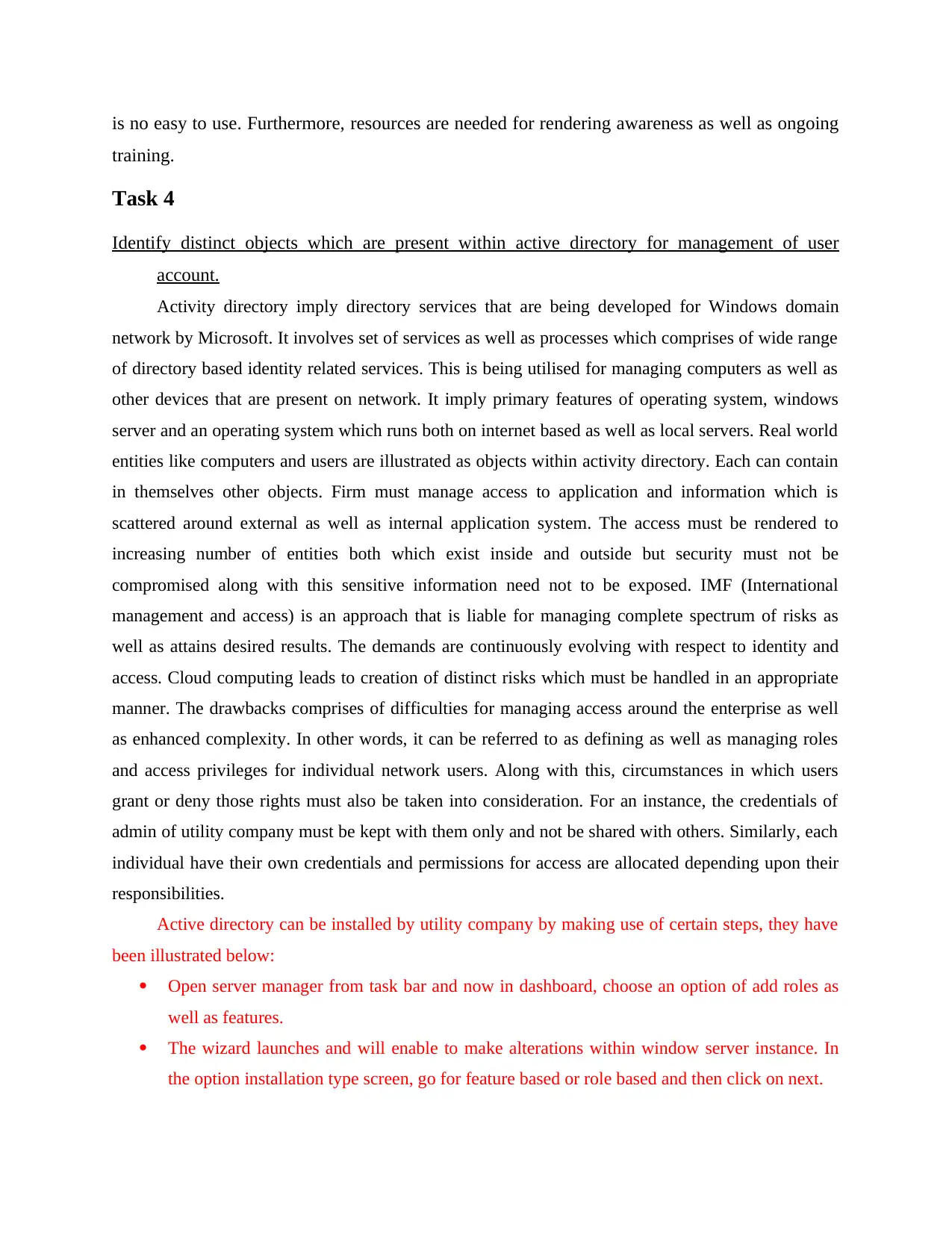
is no easy to use. Furthermore, resources are needed for rendering awareness as well as ongoing
training.
Task 4
Identify distinct objects which are present within active directory for management of user
account.
Activity directory imply directory services that are being developed for Windows domain
network by Microsoft. It involves set of services as well as processes which comprises of wide range
of directory based identity related services. This is being utilised for managing computers as well as
other devices that are present on network. It imply primary features of operating system, windows
server and an operating system which runs both on internet based as well as local servers. Real world
entities like computers and users are illustrated as objects within activity directory. Each can contain
in themselves other objects. Firm must manage access to application and information which is
scattered around external as well as internal application system. The access must be rendered to
increasing number of entities both which exist inside and outside but security must not be
compromised along with this sensitive information need not to be exposed. IMF (International
management and access) is an approach that is liable for managing complete spectrum of risks as
well as attains desired results. The demands are continuously evolving with respect to identity and
access. Cloud computing leads to creation of distinct risks which must be handled in an appropriate
manner. The drawbacks comprises of difficulties for managing access around the enterprise as well
as enhanced complexity. In other words, it can be referred to as defining as well as managing roles
and access privileges for individual network users. Along with this, circumstances in which users
grant or deny those rights must also be taken into consideration. For an instance, the credentials of
admin of utility company must be kept with them only and not be shared with others. Similarly, each
individual have their own credentials and permissions for access are allocated depending upon their
responsibilities.
Active directory can be installed by utility company by making use of certain steps, they have
been illustrated below:
Open server manager from task bar and now in dashboard, choose an option of add roles as
well as features.
The wizard launches and will enable to make alterations within window server instance. In
the option installation type screen, go for feature based or role based and then click on next.
training.
Task 4
Identify distinct objects which are present within active directory for management of user
account.
Activity directory imply directory services that are being developed for Windows domain
network by Microsoft. It involves set of services as well as processes which comprises of wide range
of directory based identity related services. This is being utilised for managing computers as well as
other devices that are present on network. It imply primary features of operating system, windows
server and an operating system which runs both on internet based as well as local servers. Real world
entities like computers and users are illustrated as objects within activity directory. Each can contain
in themselves other objects. Firm must manage access to application and information which is
scattered around external as well as internal application system. The access must be rendered to
increasing number of entities both which exist inside and outside but security must not be
compromised along with this sensitive information need not to be exposed. IMF (International
management and access) is an approach that is liable for managing complete spectrum of risks as
well as attains desired results. The demands are continuously evolving with respect to identity and
access. Cloud computing leads to creation of distinct risks which must be handled in an appropriate
manner. The drawbacks comprises of difficulties for managing access around the enterprise as well
as enhanced complexity. In other words, it can be referred to as defining as well as managing roles
and access privileges for individual network users. Along with this, circumstances in which users
grant or deny those rights must also be taken into consideration. For an instance, the credentials of
admin of utility company must be kept with them only and not be shared with others. Similarly, each
individual have their own credentials and permissions for access are allocated depending upon their
responsibilities.
Active directory can be installed by utility company by making use of certain steps, they have
been illustrated below:
Open server manager from task bar and now in dashboard, choose an option of add roles as
well as features.
The wizard launches and will enable to make alterations within window server instance. In
the option installation type screen, go for feature based or role based and then click on next.
Secure Best Marks with AI Grader
Need help grading? Try our AI Grader for instant feedback on your assignments.

The current server will be selected by default and click on next. Within screen of server roles,
check box must be selected for active directory domain services.
A notice will display option for installing different additional services, features or roles for
installing domain services. They involve federation, lightweight directory, certificate services
and management of rights. Click on add features for adding additional capabilities.
Within the select feature screen, select on check boxes which are next to services features
AD DS installation process as well as click on next.
Review information present on AD DS tab and after click on option next. Furthermore,
information can be reviewed for confirming installation selections screen and then click on
install.
Active directory groups are utilised for collection of user and computer accounts along with other
groups within manageable groups. This simplifies the network maintenance as well as
administration. There exist two groups which can be utilised by utility company to ensure security of
their systems. They are:
Distribution group: They can be utilised by utility company is that they can be only used
with email applications like exchange servers for sending emails to collecting users. They are
not security enabled which imply that they must not be listed within DACLs (discretionary
access control lists).
Security groups: They can render effective ways for assigning access to resources within
network. For this, utility company can assign user rights within the active directory. They are
being assigned for determination of what members can do in scope of domain. User rights
can be assigned automatically for some groups which are installed for helping administrators
within specified domain. Along with this, permissions must be assigned for security groups
with respect to resources so that they can be accessed whenever required.
Creation of unique passwords for administrator account is crucial step for keeping systems
secured. For this, it is important for utility company to alter the default administrator account name
with a unique one. Appropriate security strategies must be applied so that access to powers can be
restricted then audits can be carried out for activities in account. Unique password must be utilised
within each node and they need not to be a dictionary words.
For adding groups or user, the following steps can be utilised by admin of utility company to
ensure that only authenticated user have access to services which are being rendered by them. They
are:
check box must be selected for active directory domain services.
A notice will display option for installing different additional services, features or roles for
installing domain services. They involve federation, lightweight directory, certificate services
and management of rights. Click on add features for adding additional capabilities.
Within the select feature screen, select on check boxes which are next to services features
AD DS installation process as well as click on next.
Review information present on AD DS tab and after click on option next. Furthermore,
information can be reviewed for confirming installation selections screen and then click on
install.
Active directory groups are utilised for collection of user and computer accounts along with other
groups within manageable groups. This simplifies the network maintenance as well as
administration. There exist two groups which can be utilised by utility company to ensure security of
their systems. They are:
Distribution group: They can be utilised by utility company is that they can be only used
with email applications like exchange servers for sending emails to collecting users. They are
not security enabled which imply that they must not be listed within DACLs (discretionary
access control lists).
Security groups: They can render effective ways for assigning access to resources within
network. For this, utility company can assign user rights within the active directory. They are
being assigned for determination of what members can do in scope of domain. User rights
can be assigned automatically for some groups which are installed for helping administrators
within specified domain. Along with this, permissions must be assigned for security groups
with respect to resources so that they can be accessed whenever required.
Creation of unique passwords for administrator account is crucial step for keeping systems
secured. For this, it is important for utility company to alter the default administrator account name
with a unique one. Appropriate security strategies must be applied so that access to powers can be
restricted then audits can be carried out for activities in account. Unique password must be utilised
within each node and they need not to be a dictionary words.
For adding groups or user, the following steps can be utilised by admin of utility company to
ensure that only authenticated user have access to services which are being rendered by them. They
are:
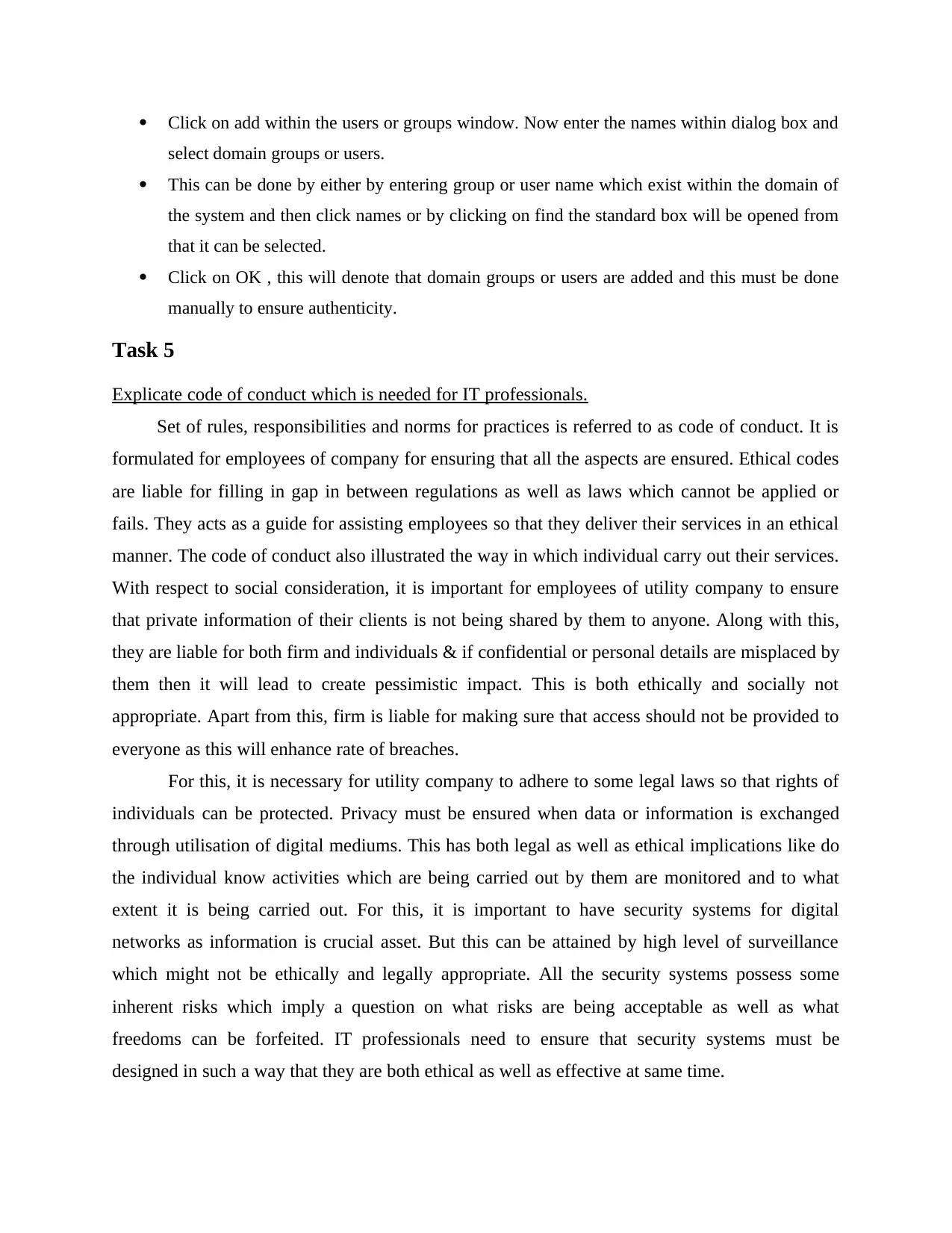
Click on add within the users or groups window. Now enter the names within dialog box and
select domain groups or users.
This can be done by either by entering group or user name which exist within the domain of
the system and then click names or by clicking on find the standard box will be opened from
that it can be selected.
Click on OK , this will denote that domain groups or users are added and this must be done
manually to ensure authenticity.
Task 5
Explicate code of conduct which is needed for IT professionals.
Set of rules, responsibilities and norms for practices is referred to as code of conduct. It is
formulated for employees of company for ensuring that all the aspects are ensured. Ethical codes
are liable for filling in gap in between regulations as well as laws which cannot be applied or
fails. They acts as a guide for assisting employees so that they deliver their services in an ethical
manner. The code of conduct also illustrated the way in which individual carry out their services.
With respect to social consideration, it is important for employees of utility company to ensure
that private information of their clients is not being shared by them to anyone. Along with this,
they are liable for both firm and individuals & if confidential or personal details are misplaced by
them then it will lead to create pessimistic impact. This is both ethically and socially not
appropriate. Apart from this, firm is liable for making sure that access should not be provided to
everyone as this will enhance rate of breaches.
For this, it is necessary for utility company to adhere to some legal laws so that rights of
individuals can be protected. Privacy must be ensured when data or information is exchanged
through utilisation of digital mediums. This has both legal as well as ethical implications like do
the individual know activities which are being carried out by them are monitored and to what
extent it is being carried out. For this, it is important to have security systems for digital
networks as information is crucial asset. But this can be attained by high level of surveillance
which might not be ethically and legally appropriate. All the security systems possess some
inherent risks which imply a question on what risks are being acceptable as well as what
freedoms can be forfeited. IT professionals need to ensure that security systems must be
designed in such a way that they are both ethical as well as effective at same time.
select domain groups or users.
This can be done by either by entering group or user name which exist within the domain of
the system and then click names or by clicking on find the standard box will be opened from
that it can be selected.
Click on OK , this will denote that domain groups or users are added and this must be done
manually to ensure authenticity.
Task 5
Explicate code of conduct which is needed for IT professionals.
Set of rules, responsibilities and norms for practices is referred to as code of conduct. It is
formulated for employees of company for ensuring that all the aspects are ensured. Ethical codes
are liable for filling in gap in between regulations as well as laws which cannot be applied or
fails. They acts as a guide for assisting employees so that they deliver their services in an ethical
manner. The code of conduct also illustrated the way in which individual carry out their services.
With respect to social consideration, it is important for employees of utility company to ensure
that private information of their clients is not being shared by them to anyone. Along with this,
they are liable for both firm and individuals & if confidential or personal details are misplaced by
them then it will lead to create pessimistic impact. This is both ethically and socially not
appropriate. Apart from this, firm is liable for making sure that access should not be provided to
everyone as this will enhance rate of breaches.
For this, it is necessary for utility company to adhere to some legal laws so that rights of
individuals can be protected. Privacy must be ensured when data or information is exchanged
through utilisation of digital mediums. This has both legal as well as ethical implications like do
the individual know activities which are being carried out by them are monitored and to what
extent it is being carried out. For this, it is important to have security systems for digital
networks as information is crucial asset. But this can be attained by high level of surveillance
which might not be ethically and legally appropriate. All the security systems possess some
inherent risks which imply a question on what risks are being acceptable as well as what
freedoms can be forfeited. IT professionals need to ensure that security systems must be
designed in such a way that they are both ethical as well as effective at same time.

Conclusion
From above it can be concluded that, computer security refers to process which can be
utilised for prevention along with detection of unauthenticated use of system. This can be carried
by physical or non-physical attacks through which intruder get access to any kind of
unauthorised access. Certain preventive measures must be taken for making sure that there
systems are protected and any third person do not get access to what is being done by them. For
ensuring that systems of utility organisation are not compromised, they can make use of threat
intelligence which comprises of information that can be utilised for acknowledging threats that
have, will or targeting the firm. Activity directory can be utilised for managing computers as well
as other devices that are present on network. Along with this, it is important for IT professionals to
take into consideration ethical, social and legal aspects with respect to security.
From above it can be concluded that, computer security refers to process which can be
utilised for prevention along with detection of unauthenticated use of system. This can be carried
by physical or non-physical attacks through which intruder get access to any kind of
unauthorised access. Certain preventive measures must be taken for making sure that there
systems are protected and any third person do not get access to what is being done by them. For
ensuring that systems of utility organisation are not compromised, they can make use of threat
intelligence which comprises of information that can be utilised for acknowledging threats that
have, will or targeting the firm. Activity directory can be utilised for managing computers as well
as other devices that are present on network. Along with this, it is important for IT professionals to
take into consideration ethical, social and legal aspects with respect to security.
Paraphrase This Document
Need a fresh take? Get an instant paraphrase of this document with our AI Paraphraser
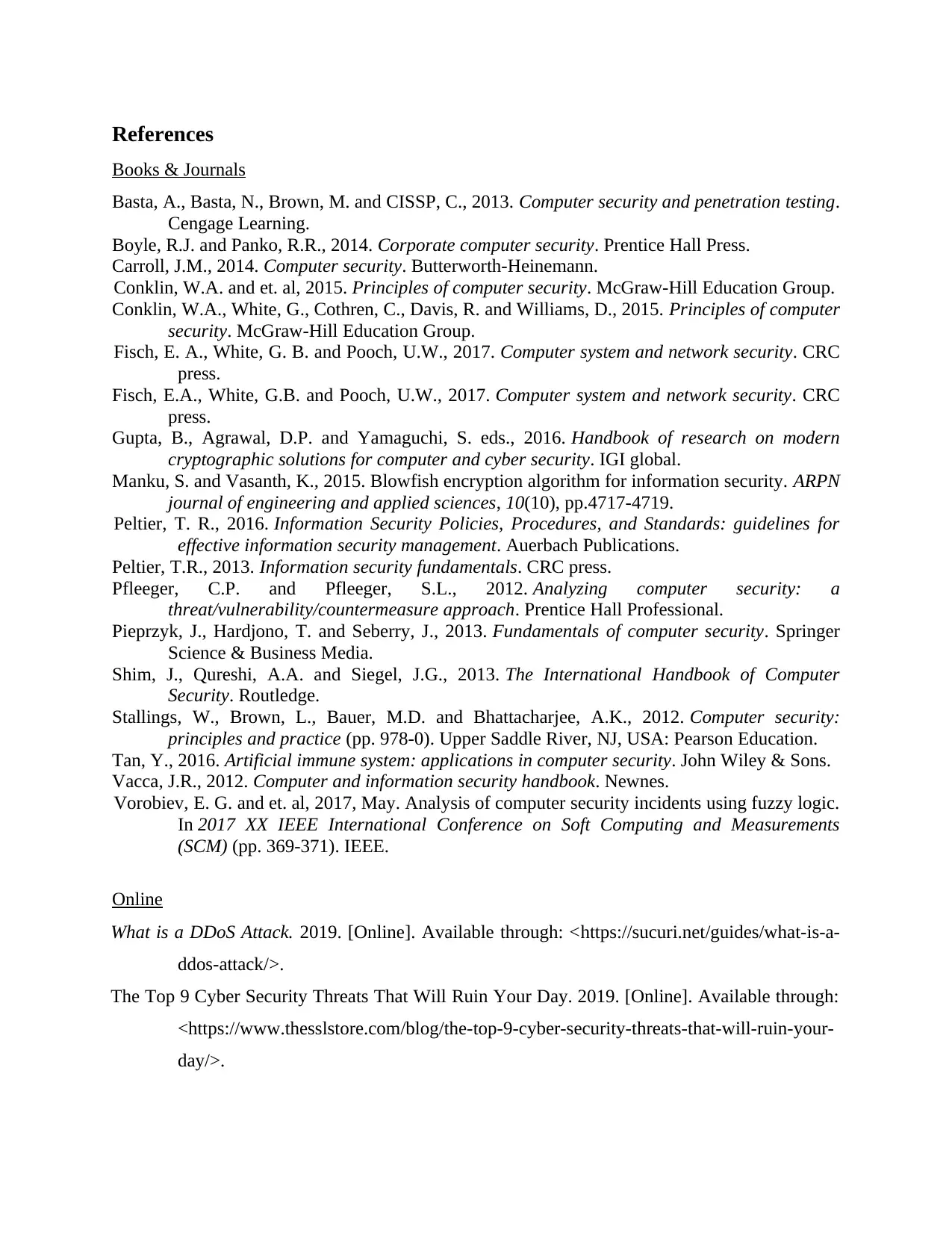
References
Books & Journals
Basta, A., Basta, N., Brown, M. and CISSP, C., 2013. Computer security and penetration testing.
Cengage Learning.
Boyle, R.J. and Panko, R.R., 2014. Corporate computer security. Prentice Hall Press.
Carroll, J.M., 2014. Computer security. Butterworth-Heinemann.
Conklin, W.A. and et. al, 2015. Principles of computer security. McGraw-Hill Education Group.
Conklin, W.A., White, G., Cothren, C., Davis, R. and Williams, D., 2015. Principles of computer
security. McGraw-Hill Education Group.
Fisch, E. A., White, G. B. and Pooch, U.W., 2017. Computer system and network security. CRC
press.
Fisch, E.A., White, G.B. and Pooch, U.W., 2017. Computer system and network security. CRC
press.
Gupta, B., Agrawal, D.P. and Yamaguchi, S. eds., 2016. Handbook of research on modern
cryptographic solutions for computer and cyber security. IGI global.
Manku, S. and Vasanth, K., 2015. Blowfish encryption algorithm for information security. ARPN
journal of engineering and applied sciences, 10(10), pp.4717-4719.
Peltier, T. R., 2016. Information Security Policies, Procedures, and Standards: guidelines for
effective information security management. Auerbach Publications.
Peltier, T.R., 2013. Information security fundamentals. CRC press.
Pfleeger, C.P. and Pfleeger, S.L., 2012. Analyzing computer security: a
threat/vulnerability/countermeasure approach. Prentice Hall Professional.
Pieprzyk, J., Hardjono, T. and Seberry, J., 2013. Fundamentals of computer security. Springer
Science & Business Media.
Shim, J., Qureshi, A.A. and Siegel, J.G., 2013. The International Handbook of Computer
Security. Routledge.
Stallings, W., Brown, L., Bauer, M.D. and Bhattacharjee, A.K., 2012. Computer security:
principles and practice (pp. 978-0). Upper Saddle River, NJ, USA: Pearson Education.
Tan, Y., 2016. Artificial immune system: applications in computer security. John Wiley & Sons.
Vacca, J.R., 2012. Computer and information security handbook. Newnes.
Vorobiev, E. G. and et. al, 2017, May. Analysis of computer security incidents using fuzzy logic.
In 2017 XX IEEE International Conference on Soft Computing and Measurements
(SCM) (pp. 369-371). IEEE.
Online
What is a DDoS Attack. 2019. [Online]. Available through: <https://sucuri.net/guides/what-is-a-
ddos-attack/>.
The Top 9 Cyber Security Threats That Will Ruin Your Day. 2019. [Online]. Available through:
<https://www.thesslstore.com/blog/the-top-9-cyber-security-threats-that-will-ruin-your-
day/>.
Books & Journals
Basta, A., Basta, N., Brown, M. and CISSP, C., 2013. Computer security and penetration testing.
Cengage Learning.
Boyle, R.J. and Panko, R.R., 2014. Corporate computer security. Prentice Hall Press.
Carroll, J.M., 2014. Computer security. Butterworth-Heinemann.
Conklin, W.A. and et. al, 2015. Principles of computer security. McGraw-Hill Education Group.
Conklin, W.A., White, G., Cothren, C., Davis, R. and Williams, D., 2015. Principles of computer
security. McGraw-Hill Education Group.
Fisch, E. A., White, G. B. and Pooch, U.W., 2017. Computer system and network security. CRC
press.
Fisch, E.A., White, G.B. and Pooch, U.W., 2017. Computer system and network security. CRC
press.
Gupta, B., Agrawal, D.P. and Yamaguchi, S. eds., 2016. Handbook of research on modern
cryptographic solutions for computer and cyber security. IGI global.
Manku, S. and Vasanth, K., 2015. Blowfish encryption algorithm for information security. ARPN
journal of engineering and applied sciences, 10(10), pp.4717-4719.
Peltier, T. R., 2016. Information Security Policies, Procedures, and Standards: guidelines for
effective information security management. Auerbach Publications.
Peltier, T.R., 2013. Information security fundamentals. CRC press.
Pfleeger, C.P. and Pfleeger, S.L., 2012. Analyzing computer security: a
threat/vulnerability/countermeasure approach. Prentice Hall Professional.
Pieprzyk, J., Hardjono, T. and Seberry, J., 2013. Fundamentals of computer security. Springer
Science & Business Media.
Shim, J., Qureshi, A.A. and Siegel, J.G., 2013. The International Handbook of Computer
Security. Routledge.
Stallings, W., Brown, L., Bauer, M.D. and Bhattacharjee, A.K., 2012. Computer security:
principles and practice (pp. 978-0). Upper Saddle River, NJ, USA: Pearson Education.
Tan, Y., 2016. Artificial immune system: applications in computer security. John Wiley & Sons.
Vacca, J.R., 2012. Computer and information security handbook. Newnes.
Vorobiev, E. G. and et. al, 2017, May. Analysis of computer security incidents using fuzzy logic.
In 2017 XX IEEE International Conference on Soft Computing and Measurements
(SCM) (pp. 369-371). IEEE.
Online
What is a DDoS Attack. 2019. [Online]. Available through: <https://sucuri.net/guides/what-is-a-
ddos-attack/>.
The Top 9 Cyber Security Threats That Will Ruin Your Day. 2019. [Online]. Available through:
<https://www.thesslstore.com/blog/the-top-9-cyber-security-threats-that-will-ruin-your-
day/>.

1 out of 15
Related Documents
Your All-in-One AI-Powered Toolkit for Academic Success.
+13062052269
info@desklib.com
Available 24*7 on WhatsApp / Email
![[object Object]](/_next/static/media/star-bottom.7253800d.svg)
Unlock your academic potential
© 2024 | Zucol Services PVT LTD | All rights reserved.





